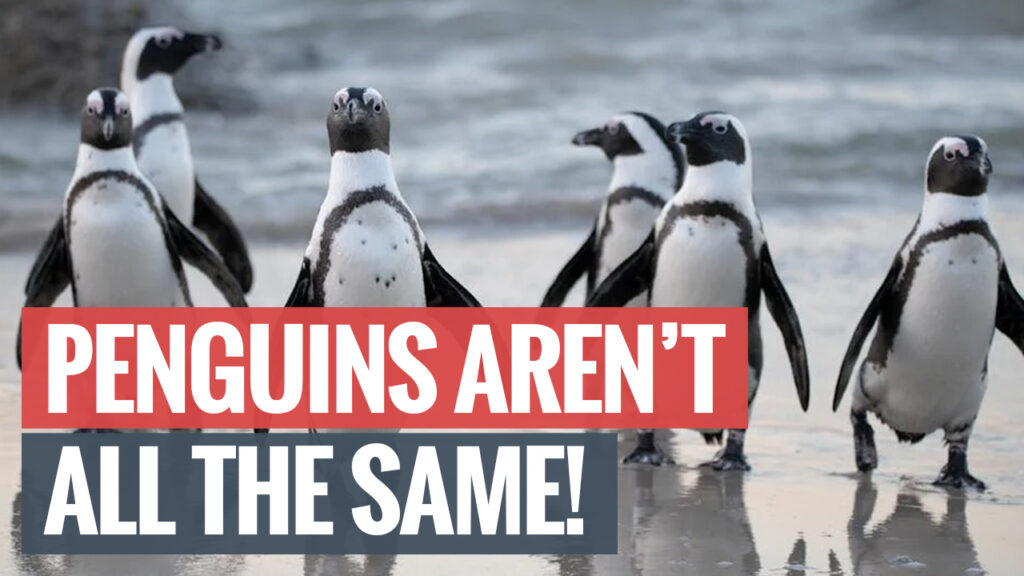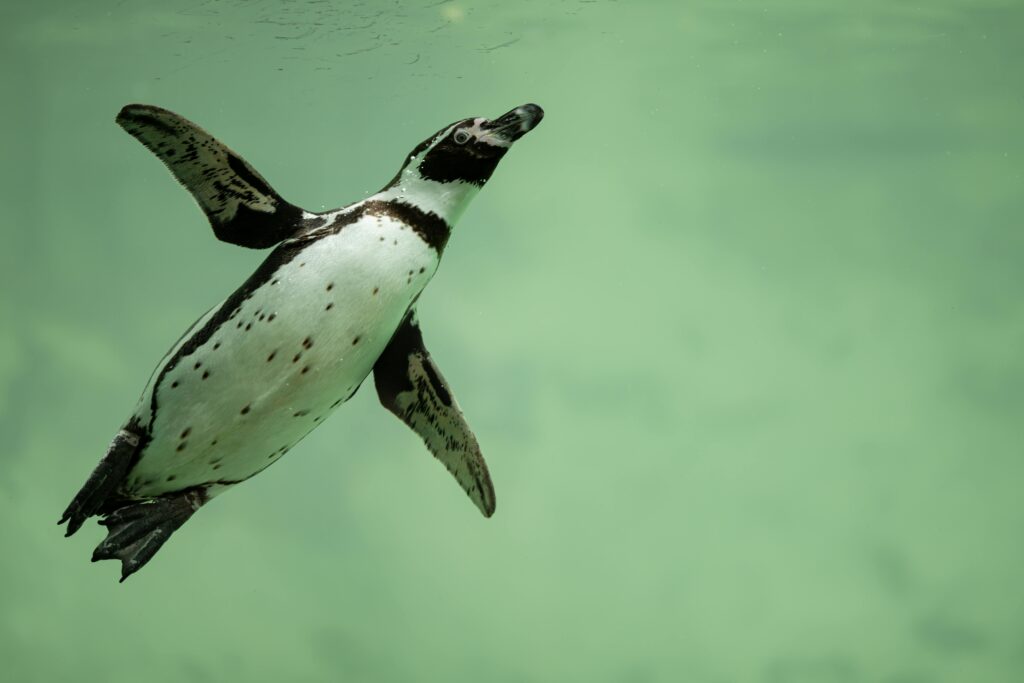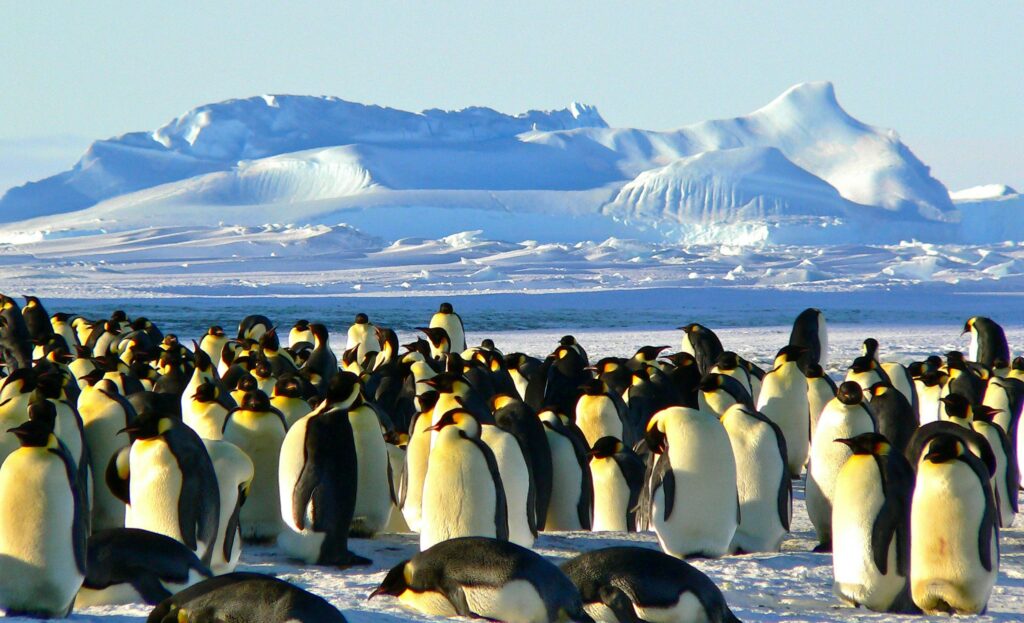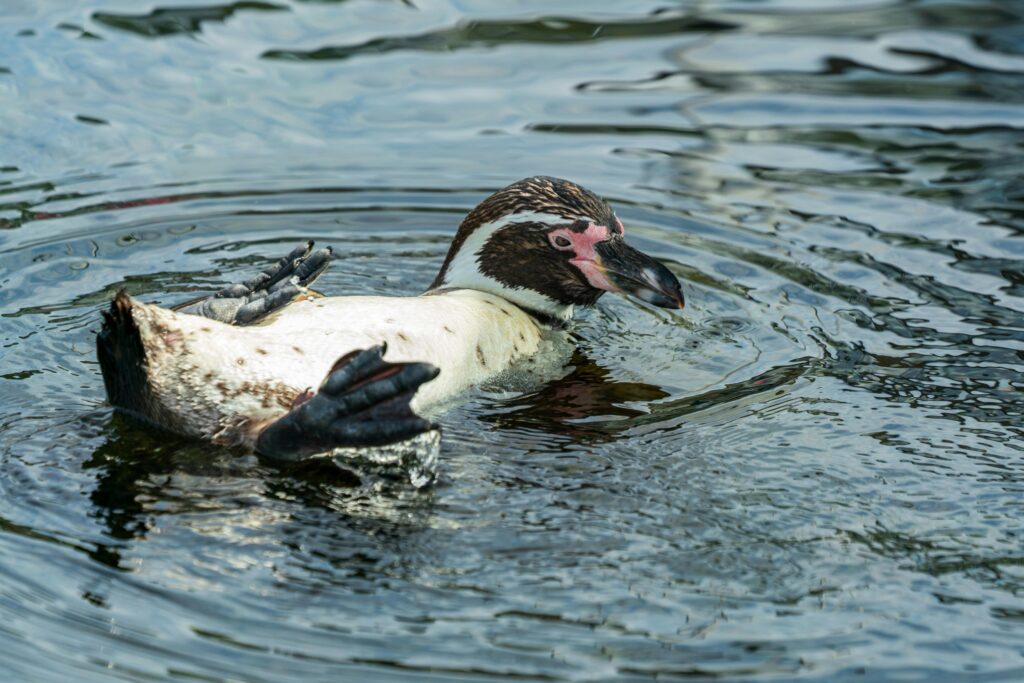Exploring the true world of our beloved penguins and uncovering the truths we must know to protect them.
A penguin standing next to a polar bear on a Christmas card, or the majestic march of Emperor penguins across an endless snowy landscape. In our minds, the image of a penguin is almost always tied to one word: ‘Antarctica.’ But what if I told you this image represents only a tiny fraction of these incredible birds? Today at ‘PenguinFriends.net,’ we’re pulling back the curtain on this long-held myth to guide you into the real world of penguins.
1. The Antarctic Icon: How Did the Misconception Begin?
The devoted Emperor penguin male, fasting for months in -60°C (-76°F) weather to incubate an egg on his feet, or the charming Adélie penguin, carrying a pebble to propose to its mate—these scenes from documentaries have filled us with awe and wonder. Masterpieces like the Academy Award-winning ‘March of the Penguins’ have cemented the penguin in the global consciousness as a symbol of survival against the harsh Antarctic environment. Indeed, the Emperor and Adélie penguins are among the few species that can truly call the Antarctic continent their home. However, these two species account for only about 10% of all penguin species. Their powerful image is merely the tip of a giant iceberg, obscuring the incredible diversity of penguins and causing the crises faced by other species to be overlooked by the public.
2. A Penguin’s Real Address: Habitats Scattered Across the Southern Hemisphere
The first fact to set straight is that penguins and polar bears would never meet in the wild. All penguin species live exclusively in the Southern Hemisphere; there are no wild penguins in the Arctic. The roughly 18 known penguin species are scattered across a wide range of environments, from the Antarctic continent to the temperate coasts and forests of Chile, Peru, South Africa, Australia, and New Zealand. Their distribution is closely linked to the flow of cold ocean currents. For example, the Humboldt and Benguela currents bring cold, nutrient-rich water to the warmer coasts of South America and Africa, creating environments where penguins can thrive.
According to the UK Antarctic Heritage Trust (UKAHT), only the Emperor and Adélie penguins primarily inhabit the Antarctic mainland. Others, like the Chinstrap or Macaroni penguins, breed on the less harsh northern tip of the Antarctic Peninsula or on sub-Antarctic islands. This means the vast majority of penguin species live not on ice, but on rocky shores, sandy beaches, and even in forests. They have each evolved unique survival strategies to adapt to their distinct environments.
3. Meeting the Penguins of Warmer Climates
It’s time to step away from the world of ice and snow and meet the penguins that live on sun-drenched beaches and in lush forests. Their stories will completely broaden your perspective on what it means to be a penguin.
The Only Penguin to Cross the Equator: The Galápagos Penguin
Living just below the equator on the Galápagos Islands, this is the only penguin species that ventures north to cross it in search of food. Their secret to surviving in a tropical climate lies in the cold Cromwell and Humboldt currents. These currents bring cool, deep-sea water and nutrients to the surface, creating a food-rich environment. However, this makes them extremely vulnerable to the El Niño phenomenon. When El Niño occurs, sea surface temperatures rise, food becomes scarce, and their population plummets. With only about 1,200 individuals remaining according to the International Fund for Animal Welfare (IFAW), they are one of the rarest penguins in the world and are critically endangered. To escape the hot sun, they have a unique survival strategy of nesting and laying their eggs in caves and crevices formed by hardened lava.
Africa’s Only Native: The African Penguin
Living on the coasts of South Africa and Namibia, these penguins are also known as “Jackass Penguins” because of their donkey-like bray. Their most distinctive feature is the pink gland above their eyes. When they get hot, blood is sent to these glands to be cooled by the surrounding air, acting as a natural ‘air-conditioning system.’ But their future is bleak. Due to overfishing of their main food sources (sardines and anchovies) and shifting currents from climate change, their population has plummeted by over 97% in the last century. As a result, their threat level was recently upgraded to ‘Critically Endangered.’ Their existence is a stark reminder that penguins are a vital part of Africa’s continental ecosystem.
The World’s Smallest Penguin: The Little Blue Penguin
Also known as the ‘Fairy Penguin’ or ‘Kororā,’ this is the world’s smallest penguin, found in southern Australia and New Zealand. Standing only about 30 cm (12 inches) tall, they have beautiful blue-tinged feathers, as their name suggests. They are the only penguin species that is nocturnal on land, spending their days hunting at sea and returning to shore in groups after sunset to avoid predators. The ‘Penguin Parade’ on Phillip Island, Australia, is a famous ecotourism attraction where visitors from around the world gather to watch their return. They live in burrows in sand dunes or among rocks and sometimes nest near urban areas, making them vulnerable to car accidents and attacks by pet dogs.
New Zealand’s Forest Penguins: The Fiordland and Yellow-eyed Penguins
New Zealand is a hotspot for penguin diversity, and it’s home to penguins that live in forests. The Fiordland Penguin (Tawaki) is the only penguin in the world that lives in a temperate rainforest. They build their nests among tree roots, under fallen logs, or in caves, and are so secretive they are sometimes called ‘ghosts of the forest.’ Meanwhile, the Yellow-eyed Penguin (Hoiho) is one of the world’s rarest penguins, nesting in coastal forests and scrubland. However, due to introduced predators (like stoats and cats), habitat loss, and disease, their population has declined dramatically and they are now facing a severe risk of extinction.
4. Why This Myth is Dangerous: A Conservation Blind Spot
The misconception that “all penguins live in Antarctica” is more than just a geographical error. It’s a veil that obscures the multi-layered and complex threats penguins face, hindering effective conservation efforts.
Antarctic penguins are primarily affected by climate change through the loss of sea ice, which is their breeding ground and a nursery for their food source, krill. But penguins in temperate and tropical regions are fighting entirely different battles. The threats they face vary by habitat:
- South America (Humboldt, Galápagos): These penguins have lost breeding grounds due to the over-harvesting of guano (bird droppings), which they need for nesting. Additionally, rising sea temperatures from El Niño events cause food shortages that directly threaten their survival.
- South Africa (African): Direct competition with humans for food is their biggest problem. Commercial overfishing of sardines and anchovies is driving them to starvation, and oil spills are another deadly threat.
- Australia/New Zealand (Little Blue, Yellow-eyed): Introduced predators (dogs, cats, stoats) are the greatest threat. Habitat destruction from coastal development and stress from increased tourism are also major causes of population decline.

If we only think of penguins as ‘creatures of the Antarctic ice,’ we miss these diverse and urgent conservation issues. Penguins in different habitats require different, tailored solutions.
5. What Recent Science Tells Us: A Changing World and the Future of Penguins
Advances in technology are dramatically changing our understanding of penguins. Satellites are now used to discover previously unknown Emperor penguin colonies by analyzing the brown stains left by their droppings (guano) from space. In early 2024, four new colonies were found this way. While this is hopeful news, it also reveals a grim reality. A study published in June 2025 reported that Emperor penguin populations in some parts of Antarctica have plummeted by 22% over the last 15 years. This is faster than even the most pessimistic climate model predictions, showing that the impact of the climate crisis on penguins is far more severe than we thought.
Furthermore, climate change is creating ‘winners’ and ‘losers’ among penguin species. On the Antarctic Peninsula, as sea ice shrinks, so do the krill populations. This has caused a sharp decline in Adélie and Chinstrap penguins, which rely on krill. In contrast, the Gentoo penguin, which has a more varied diet of squid and fish, is actually expanding its range into newly ice-free land and its population is growing. This is a clear example of how climate change is not just raising temperatures, but fundamentally altering the food web and the competitive balance between species.
6. Our Role: What It Means to Be a True Penguin Friend
Penguins are not a single image, but 18 incredible stories of survival, each unfolding in a unique environment. From the lava shores of the Galápagos to the temperate rainforests of New Zealand and the ice sheets of Antarctica, their homes are astonishingly diverse.
Understanding this diversity is the first step to becoming a true ‘penguin friend.’ Instead of seeing them merely as cute Antarctic mascots, we must listen to the real threats they face. Protecting penguins goes beyond just saving the Antarctic ice; it includes concrete actions like these:
- Choose Sustainable Seafood: By selecting seafood with certifications like the Marine Stewardship Council (MSC), you can help reduce the overfishing that depletes the penguins’ food sources.
- Reduce Marine Pollution: Cutting down on single-use plastics and participating in beach cleanups can reduce the deadly plastic waste that harms penguins and other marine life.
- Be a Responsible Tourist: When visiting penguin habitats, always follow designated rules, maintain a respectful distance to avoid stressing the birds, and adopt an attitude of respect for the local ecosystem.
- Support and Participate in Conservation: You can support field organizations like SANCCOB in South Africa or the Yellow-eyed Penguin Trust in New Zealand, or even contribute to penguin research from home by participating in citizen science projects like Zooniverse’s ‘Penguin Watch.’
Now that you know the real world of penguins, why not take a moment to think about what we can do for these amazing creatures? Listening to their stories is the first small flap of a wing that can start to change the world.




